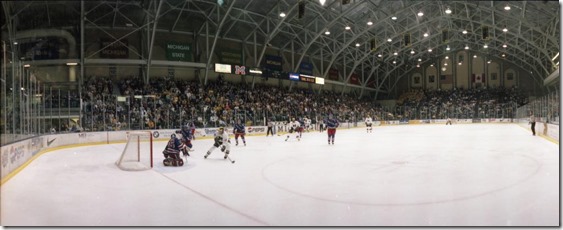bubba berenzweig
Previously: Part One, Part Two
[Yost in the late ‘90s/Kalmbach via Bentley Historical Library]
Michigan’s heralded 1993 and 1994 recruiting classes began paying dividends immediately. The 1993-94 Wolverines had three winning streaks of seven games or longer in just a 41-game season, the longest of which reached 11 games. The 1994-95 team took something of a step back—their longest winning streak was only nine games—while still winning 30 games and finishing first in the CCHA.
The most dominant streak of the decade dovetailed with the vaunted recruits becoming upperclassmen. The nature of collegiate hockey scheduling left its mark on previous winning streaks; many took place across multiple road series with neutral-site games sprinkled in. In 1995-96, however, Michigan’s offense hit its stride just as the Wolverines returned home for a six-game homestand at the beginning of January. Their eight-game winning streak started with a GLI title that they took by a combined score of 9-2. They put up even gaudier numbers in front of their own crowd, averaging 9.6 goals per game over six home contests.
The season ended with Michigan’s first national championship in 32 years; before they got there, goalies were pulled, the wooden bleachers creaked and swayed, the crowd beyond the students got involved, and for opponents, the ghosts of Yost were growing louder.
-------------------------------
Brendan Morrison, forward (1993-97): That was an incredible stretch. I think we averaged that month or six weeks or whatever it was, we averaged something ridiculous like 8.7 goals a game or something like that. [Ed. A—They averaged 7.6 goals per game over the ten games from the GLI at the end of December through the end of January and the aforementioned 9.6 goals per game counting just the six-game January homestand.] Just absurd. I know every single home game we played, the other team’s goalie was pulled at some point. I don’t think it was a very fun place for other teams to come in and play. They knew they were walking into kind of the lion’s den there; we were rolling and scoring a bunch of goals. It was intimidating. I remember other programs coming out and verbalizing that it was a tough place to play. It was difficult. It’s almost like with our fans and playing in that arena, it was like you were up 1-0 or 2-0 before the game even started.
Marty Turco, goaltender (1994-98): For me, having us rolling teams, you look at the scores and you’re like rolling teams, yeah, 8-3, 7-2, 10-4. You’re like, Alright. Everybody else was happy except for Red because Red was like, “No one cares because we won and we dominated but how about those two you let in there?” I might not have been needed as much to have the game on the line early and mid-year, but he wanted to make sure I was the guy he thought I was at the end of the year. So it wasn’t all hunky-dory during that year [1995-96] for me in particular but it was huge in terms of growth.
Tim Carmody, student season ticket holder: It was exciting. It was definitely very relevant. People would go all the time. People would show up a little bit later for parties on hockey nights.
[After THE JUMP: the crowd’s creativity, the environment’s advantage, and the quirks of an old barn]

12